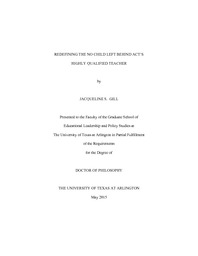| dc.description.abstract | This study shares the perspectives of eight, current Highly Qualified Teachers (HQT) and provides some insight into the points of view of these teachers who are directly affected by the decisions and policies handed down from lawmakers. There is value in deeply understanding the impact of the requirements set forth by the No Child Left Behind Act of 2001's (NCLB) definition of the Highly Qualified Teacher as it can help shape future policies to better serve the students it is intended to assist. For this study, participants engaged in an in-depth semi-structured interview and provided demographic data and classroom artifacts. The researcher used a basic qualitative research design to present how NCLB's definition of the Highly Qualified Teacher has been/is being interpreted and how it has affected and continues to affect the ways in which educators construct their real-world classrooms. In addition, the researcher sought to: a) ascertain how well current secondary HQTs delineate their proficiency with the subject(s) they teach; b) impart the perspectives of what current secondary HQTs feel it takes to be prepared to enter the classroom; c) convey the perspectives of how current secondary HQTs feel the government's requirements for becoming a HQT helped to prepare them for the realities of the classroom; and d) based on the findings, recommend policy reform to better meet the needs of current and future teachers. The findings of this study revealed that the current definition of the Highly Qualified Teacher, as defined by the No Child Left Behind Act of 2001, is inadequate to meet the needs and challenges of today's classrooms. Based on the data collected for this study, the following six changes to policy were recommended: 1) The language used in the definition of the Highly Qualified Teacher needs to be more specific and the loopholes need to be closed. 2) Policy needs to be informed by Highly Qualified teachers and educators currently working in the school system. 3) As part of their teacher preparation program, all teacher candidates should be required to engage in student teaching. 4) In addition to the requirement for a four-year degree, all Highly Qualified Teachers must complete a minimum of 12 hours of coursework in the content that they teach. 5) The federal government must set some basic guidelines that all educator programs must follow. One of these guidelines must include a call for the introduction of realistic teaching opportunities. 6) Composite exams should be phased out and replaced by subject specific exams that test for knowledge and depth. The Pedagogical and Professional Responsibilities EC-12 exam must be completely reworked to reflect the realities of teaching. Finally, exam attempts should be capped and uncertified teachers should not be allowed to teach beyond a year. | en_US |

